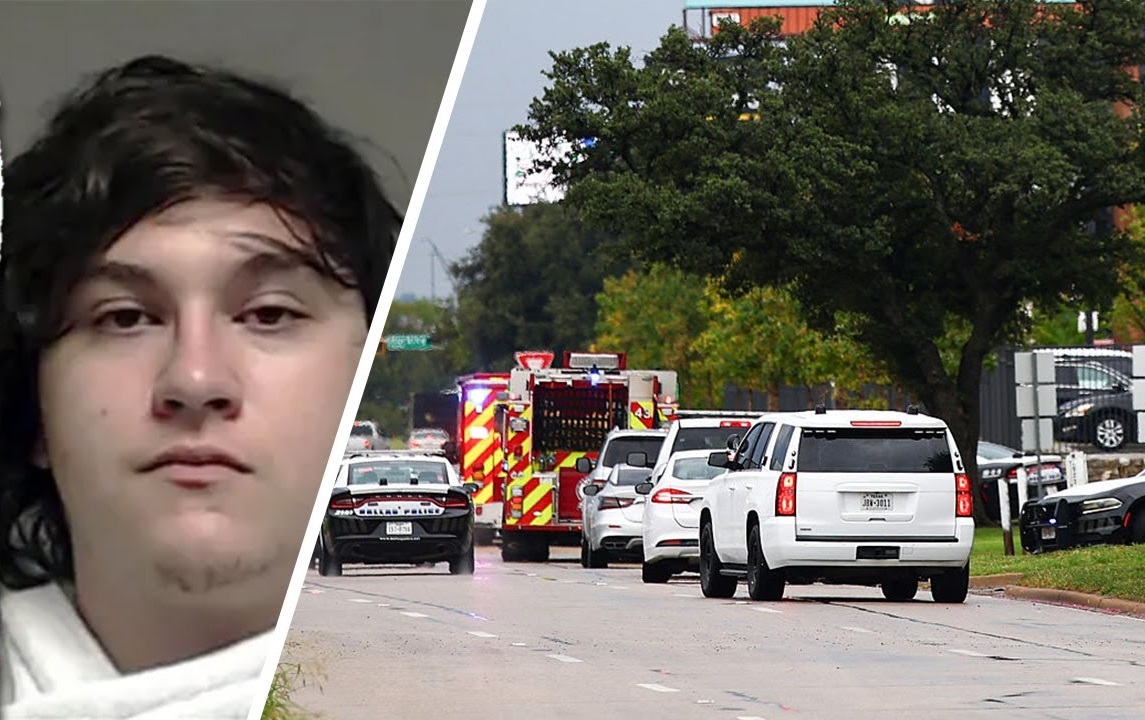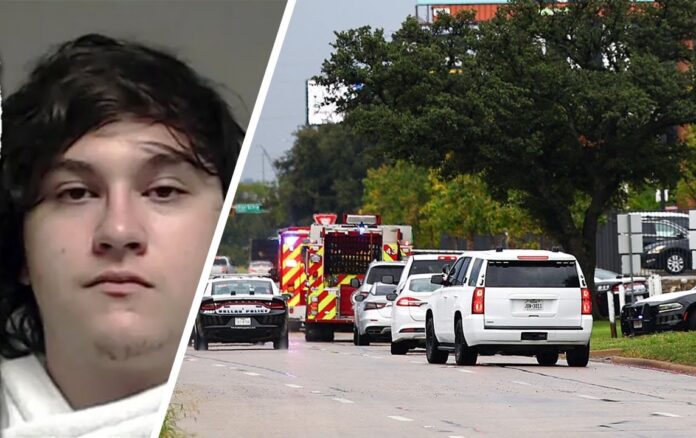He etched “ANTI-ICE” on bullets, perched on a rooftop like a ghost, and rained hell on federal agents—killing one innocent migrant instead. What snapped Joshua Jahn, the 29-year-old drifter who turned Dallas into a war zone?
A twisted manifesto dreamed of “real terror” for ICE heroes. Lone wolf or symptom of a broken America? The full, gut-wrenching dossier awaits…

A quiet predawn shift at a bustling immigration processing center shattered into chaos when sniper fire pierced the morning fog, claiming the life of one detainee and leaving two others in critical condition. The gunman, perched on a nearby rooftop with a bolt-action rifle, wasn’t aiming for glory or escape—he ended his own life as law enforcement closed in, leaving behind a trail of etched bullets, handwritten rants, and a digital footprint that painted him as a lone wolf fueled by seething hatred for the federal government.
Joshua Jahn, 29, of Fairview, Texas, was identified by authorities as the shooter who targeted the U.S. Immigration and Customs Enforcement (ICE) field office on North Stemmons Freeway in Dallas’s Love Field neighborhood on September 24. What began as a routine transport of detainees turned deadly around 6:40 a.m., when Jahn allegedly unleashed 17 rounds from an 8mm bolt-action rifle—some marked with the scrawled phrase “ANTI-ICE” in blue ink—into the facility’s secured courtyard and an unmarked transport van. The victims, all immigration detainees awaiting processing, bore the brunt of his indiscriminate barrage: one Venezuelan father of three killed instantly, and two others rushed to Parkland Memorial Hospital with life-threatening wounds.
The attack, the third shooting at a Department of Homeland Security (DHS) facility in Texas this year, has thrust ICE operations into the national spotlight amid President Donald Trump’s aggressive deportation push. Acting ICE Director Todd Lyons announced heightened security alerts nationwide, while Texas Gov. Greg Abbott vowed to accelerate removals, calling the incident “an assassination that won’t deter justice.” As FBI teams comb Jahn’s sparse apartment and family home, a portrait emerges of a directionless young man whose simmering grievances against authority boiled over into calculated violence—planned with the precision of a marksman, yet executed with tragic irony.
Dallas Police Chief Daniel Comeaux described the scene at a tense afternoon briefing: “This was no random act. The shooter positioned himself on the roof of an adjacent law office, firing into our sallyport where detainees were loading up. Agents returned fire, but he turned the gun on himself before we could take him down.” Surveillance footage released Friday shows ICE personnel—some diving for cover, others shielding detainees with their bodies—rushing migrants to safety amid the hail of bullets. “These officers ran toward the gunfire, not away from it,” Comeaux added, his voice steady but edged with fury. No agents were harmed, a fact Lyons credited to “instinct and heroism” in the face of what the FBI now classifies as “targeted domestic terrorism.”
The facility, a squat concrete bunker processing hundreds of migrants daily under Trump’s expanded enforcement mandate, became a fortress overnight. Barricades went up, and patrols doubled, as protesters—both pro- and anti-deportation—gathered outside, their chants clashing like echoes of the shots fired. “This isn’t just an attack on ICE; it’s an assault on the rule of law,” Acting U.S. Attorney Nancy Larson said Thursday, flanked by FBI Director Kash Patel. “Jahn wanted to paralyze federal workers, to make them fear every shadow. What he did was terrorism, plain and simple.”
The Shooter: A Lost Soul’s Descent into Rage
Joshua Jacob Jahn grew up in the quiet Collin County suburbs north of Dallas, the younger of two sons in a middle-class Norwegian-American family. Born in Texas around 1996, he navigated a childhood marked by stability on the surface but isolation underneath, according to neighbors and school records. His parents, both retired educators, lived in a modest ranch-style home in Fairview, where Jahn and his older brother Noah shared a room lined with Boy Scout badges and sci-fi novels. “Josh was the quiet one—good with puzzles, bad with people,” recalled a former troop leader who spoke on condition of anonymity. “He’d vanish into his head during hikes, muttering about ‘systems that trap us all.'”
High school at McKinney Boyd was unremarkable: average grades, a handful of friends from the robotics club, and no disciplinary flags. But cracks appeared post-graduation. Jahn enrolled sporadically at Collin College from 2013 to 2018, bouncing between undeclared majors—brief stints in computer science and environmental studies—without earning a degree. Retail gigs at big-box stores followed, each lasting months before burnout or boredom set in. By 2015, trouble knocked: a Collin County arrest for marijuana delivery, where he admitted to trafficking between a quarter-ounce and five pounds. Slapped with a state jail felony—the lightest felony charge in Texas—he drew five years’ probation and a $500 fine, emerging with a record that haunted job hunts.
In late 2017, seeking reinvention, Jahn drove cross-country to Benton City, Washington, living out of his battered Ford Focus while harvesting legal cannabis on a minimum-wage farm. Employer Ryan Sanderson painted a bleak picture to The Associated Press: “He was a young kid, a thousand miles from home, didn’t seem to have any direction. Lived in his car, rambled about government conspiracies over lunch. I felt sorry for him, but he was unreliable—always late, always lost.” Fired after a season, Jahn drifted back to Texas, couch-surfing with distant relatives in Durant, Oklahoma, where he registered as an independent voter and cast a ballot in the 2020 Democratic primary.
Those close to him insist the radical turn blindsided everyone. Noah Jahn, speaking haltingly to Reuters before official confirmation, described his brother as “unique” but apolitical: “He didn’t rant about ICE or borders. We’d talk video games, not vendettas. If he hated the feds, he hid it deep.” A Boy Scout buddy echoed the shock, recalling a casual chat years back on migrant caravans: “Josh was upset about the desperation, how immigration got politicized. Passionate, sure—but not the action type. Never violent.” Yet, online breadcrumbs tell a darker tale. Jahn’s sparse X account—under a handle now suspended—liked posts decrying “human trafficking rings” in federal agencies, with ICE as the prime villain. He devoured forums on ballistics and the September 10 sniper assassination of conservative activist Charlie Kirk in Utah, downloading manuals on armor-piercing rounds and facility blueprints.
The FBI’s raid on his Fairview bedroom uncovered the manifesto: dog-eared notebooks scrawled with fury. One page, titled “Gameplan,” sketched the rooftop vantage, timing for dawn transports, and escape routes that dissolved into “solo endgame.” Another raved: “ICE agents are human traffickers in suits—dirty paychecks for caging souls. Time to make them taste fear.” A chilling closer: “Yes, it was just me and my brain. Hopefully this gives ICE real terror: ‘Is there a sniper with AP rounds on that roof?'” Investigators found no ties to organized groups—no Antifa chats, no anarchist cells—just a solitary spiral, amplified by echo-chamber algorithms.
Jahn’s family, huddled in their Fairview home as agents hauled out boxes, issued a raw statement Friday: “We’re shattered. Josh struggled silently—we wish we’d seen the storm. To the victims’ families, ‘I’m so sorry’ doesn’t cut it, but it’s all we have.” Neighbors, Norwegian flags still fluttering from a recent heritage festival, whispered of a “good boy gone wrong,” blaming untreated isolation in a post-pandemic world.
The Rampage: Precision Planning, Tragic Misfire
Jahn’s assault unfolded with eerie method. Digital forensics show he arrived at the site around 3 a.m., scaling the law office roof under cover of darkness—his rifle, a WWII-era Mauser K98 clone, scoped for 300 yards. He’d stalked the facility for weeks via apps tracking ICE vans, downloading a DHS directory of Texas outposts. At 6:30 a.m., as detainees shuffled into the courtyard for paperwork and busing, he struck—bullets punching through van windows, shattering glass, and embedding in walls.
The irony stings: Jahn aimed to “maximize lethality against ICE personnel,” per Larson, firing at transport vehicles he mistook for agent-only. Instead, the rounds felled detainees—non-English speakers from Venezuela and Central America, ensnared in Trump’s deportation dragnet. The dead man, 34-year-old Carlos Ramirez, left three U.S.-born kids and a wife pleading asylum on gang threats back home. “He came for safety, died in chains,” his attorney wept at a vigil. The wounded, stabilized by Friday, face long recoveries; one lost a kidney to shrapnel.
Agents’ valor shone in the footage: burly figures in tactical vests forming human walls, dragging migrants behind concrete barriers as pops echoed. “They saved lives that morning,” Patel posted on X, sharing shell casings etched “ANTI-ICE”—a nod to recent engravings on bullets in the Kirk slaying and UnitedHealthcare CEO hit. By 6:50 a.m., SWAT breached the roof; Jahn, cornered, put a final round through his temple. His body, slumped amid casings, clutched a final note: “The system breaks us all.”
The facility, now a crime-scene hive, buzzed with feds in hazmat suits sifting for prints. Aerials from FOX 4 showed tape encircling the block, with a suspect’s sedan—Texas plates, weed stickers—towed for forensics. No explosives, no accomplices—just a ghost’s grudge.
A Nation on Edge: Echoes of Broader Fury
This sniper’s nest hits like a gut punch in a year of flashpoints. Trump’s September 1 executive order ramped deportations to 1 million annually, swelling facilities like Dallas’s to bursting—protests erupted in Chicago suburbs, where a left-wing agitator was nabbed with a firearm just 48 hours post-attack. DHS Secretary Kristi Noem ordered perimeter upgrades nationwide, citing “rhetoric turning toxic.” Critics on the left decry overreach; Abbott retorts, “This won’t slow our arrests—one assassin’s tantrum changes nothing.”
X lit up with raw takes: #JusticeForCarlos trended with 150,000 posts from migrant advocates, while #BackTheBlue hailed agents as “unsung shields.” Memes juxtaposed Jahn’s mugshot—a lanky kid with haunted eyes—against Kirk’s bloodied stage, fueling conspiracies of a “red wave of radicals.” One viral clip from the Boy Scouts troop: grainy footage of teen Jahn earning a marksmanship badge, captioned “From Eagle Scout to executioner.”
Experts see patterns in the pain. Dr. Elena Vasquez, a radicalization specialist at UT Dallas, links Jahn’s arc to “lost boys” adrift in economic flux—Texas youth unemployment at 12%, mental health waits stretching months. “He wasn’t Antifa; he was alone, amplified by dark web whispers. Untreated isolation plus anti-fed memes equals ignition.” The Kirk echo chills: Jahn’s searches spiked post-Utah, downloading hit videos like blueprints for his own end.
Political crossfire flares. Democrats like Rep. Jasmine Crockett, whose district hugs the facility, blasted “deportation fever” for breeding backlash; Republicans countered with “open-borders blood on blue hands.” Patel, briefing Congress, urged algorithm audits: “Platforms peddle hate; we need walls, digital and real.”
Aftermath: Mourning, Mandates, and a Call to Heal
Vigils dotted Dallas by weekend’s end: green-clad migrants lighting candles for Ramirez outside Parkland, their hymns mingling with agent salutes at a fallen-detainee memorial. ICE’s welfare arm dispatched counselors, while the Venezuelan consulate fast-tracked visas for his kin. “Carlos fled cartels for this? America, we failed him,” sobbed his sister via Zoom.
Reforms rumble. Noem’s directive funnels $20 million to facility forts—drones, barriers, AI cams—while Abbott pitched a “Texas Shield” bill for state-federal fusion centers. Mental health hawks push VA expansions for at-risk vets’ kin, though Jahn’s family denies service ties. On X, Noah Jahn pleaded: “Don’t paint us all with his brush. Josh was broken; help the next one before the trigger.”
As the sun dipped over Stemmons Friday, a lone agent patrolled the rooftop scar, rifle slung low. Jahn’s ghost lingers—not as martyr or monster, but warning: In a polarized republic, one man’s manifesto can scar a city. How many more rooftops hide the next spark? For Dallas, the answer hides in the silence between shots—a plea for borders that bind, not break.
